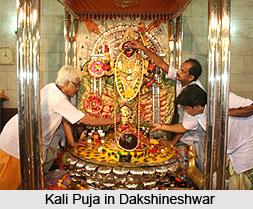 Kali Puja or Shyama Puja as it is also popularly known as is dedicated to Hindu Goddess Kali, which is celebrated on the new day of the Hindu month Ashwin in Bengal. This pujo coincides with the pan-India Lakshmi Puja on the day of Diwali. While the Oriyas, Assamese and Bengalis adore and worship goddess Kali on this day, the rest of the country celebrates goddess Lakshmi.
Kali Puja or Shyama Puja as it is also popularly known as is dedicated to Hindu Goddess Kali, which is celebrated on the new day of the Hindu month Ashwin in Bengal. This pujo coincides with the pan-India Lakshmi Puja on the day of Diwali. While the Oriyas, Assamese and Bengalis adore and worship goddess Kali on this day, the rest of the country celebrates goddess Lakshmi.
History of Kali Puja
The celebration of Kali Puja is not an ancient concept as it was practically unknown to people during the 18th century. But during the late 17th century devotional text by Balram named Kalika Mangalkavya mentions an annual festival dedicated to Kali. It was actually done in Bengal during the 18th century by King (Raja) Krishnachandra of Navadvipa. It was during the 19th century that Kali Puja gained popularity when Krishnachandra`s grandson Ishvarchandra and part of Bengali elite, rich landlords began to patronize the festival on a large scale. Presently we see that Kali Puja, along with Durga Puja is the biggest goddess festival in West Bengal.
Worship of Kali Puja
Just like Durga Puja in Kali Puja too, the worshipper honour the clay idol of the goddess Kali in their homes or in Pandals (open pavilions or temporary shrines). She is worshipped and adored at night time with mantras and tantric rites. She is offered red hibiscus, sweets, rice, lentils, meat, fish and animal blood in a skull. The worshipper must also meditate throughout the night until dawn. In Hindu household this puja is celebrated in a typical Hindu Brahmanical style that involves dressing of Kali in her Adya Shakti Kali form. Animals are ritually sacrificed on Kali Puja and are offered to the goddess. In most part of West Bengal the worship of Kali Puja is held in a large cremation ground where she is believe to dwell.
The pandals also house images of Lord Shiva- the consort of Goddess Kali, Bamakhepa and Ramkrishna- two famous Bengali Kali devotes or follower along with pictures from mythology of Kali and her various forms along with Dasa Mahavidyas, popularly called the "Ten Kalis". The Dasa Mahavidyas is actually an assemblage of ten Tantric goddesses led by goddess Kali. Devotees from all state visit these pandals all throughout the night. Kali Puja is also the time for fireworks, theatre and magic shows. Drinking good wine happens to be the new custom followed during the Kali Puja.
The Kalighat Kali Temple in Kolkata is a popular place which worships the Goddess Kali. On the day of Kali Puja Kalighat Temple is decorated in new avatar, with flowers and lights. The celebration is done to reflect the essence and feel of Vaishnava Haldars on Kali worship. Thousands of followers and devotees throng the place on the day of puja and offer animal sacrifice to the goddess.
In Kolkata another popular temple which is dedicated to Goddess Kali is the Dakshineshwar Kali Temple, whose priest, was the renowned Kali devotee named Ramakrishna. The celebrations have changed little from his time.





